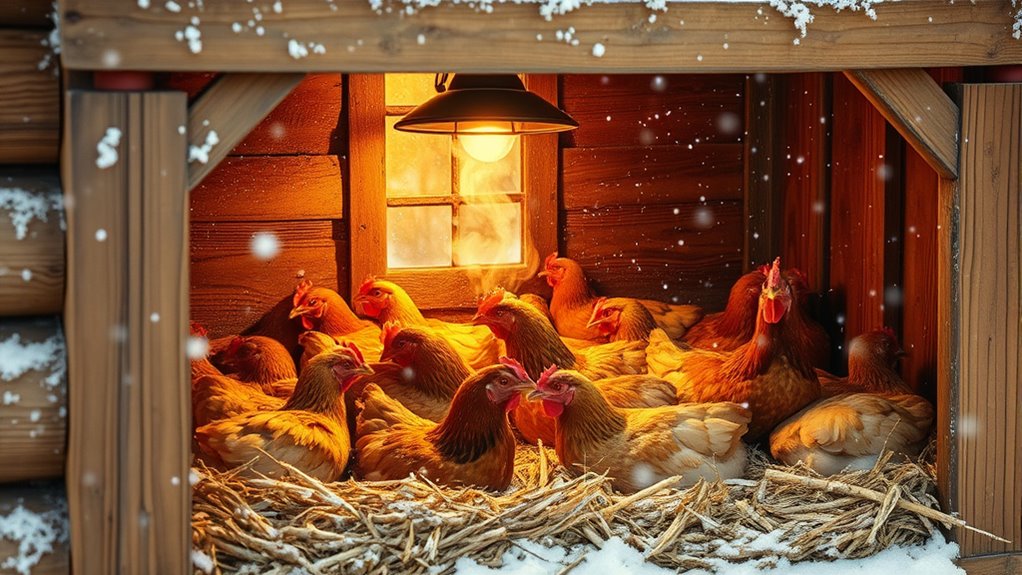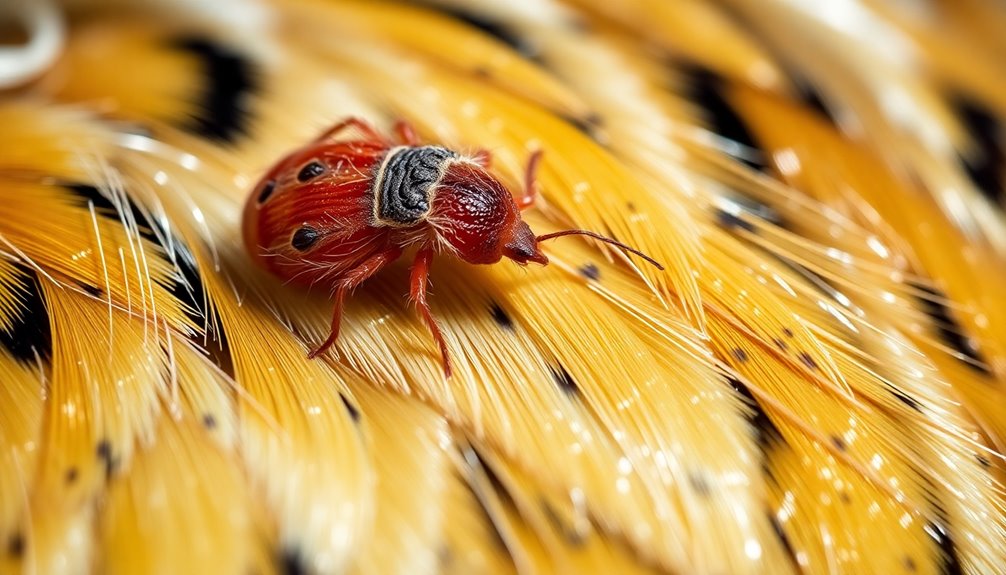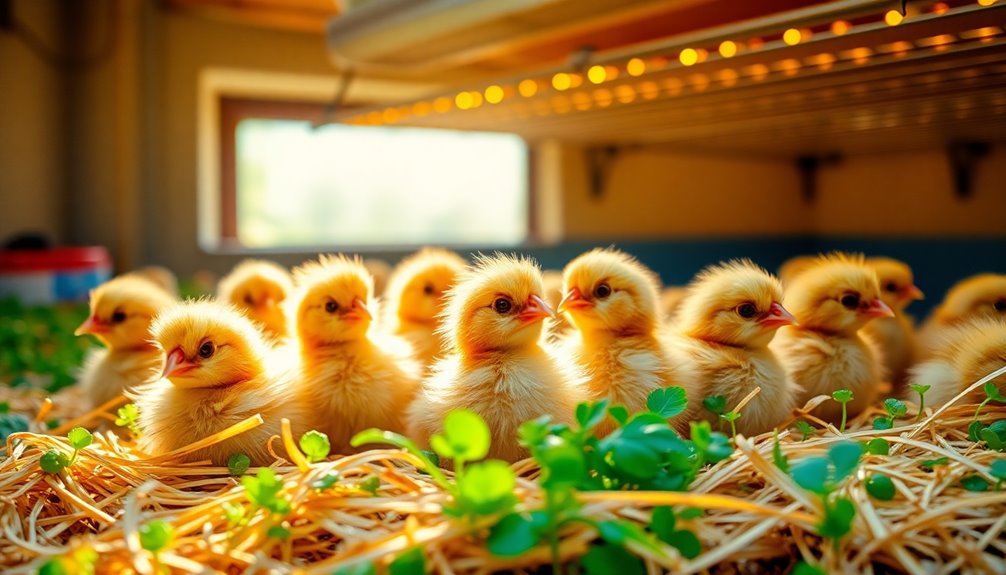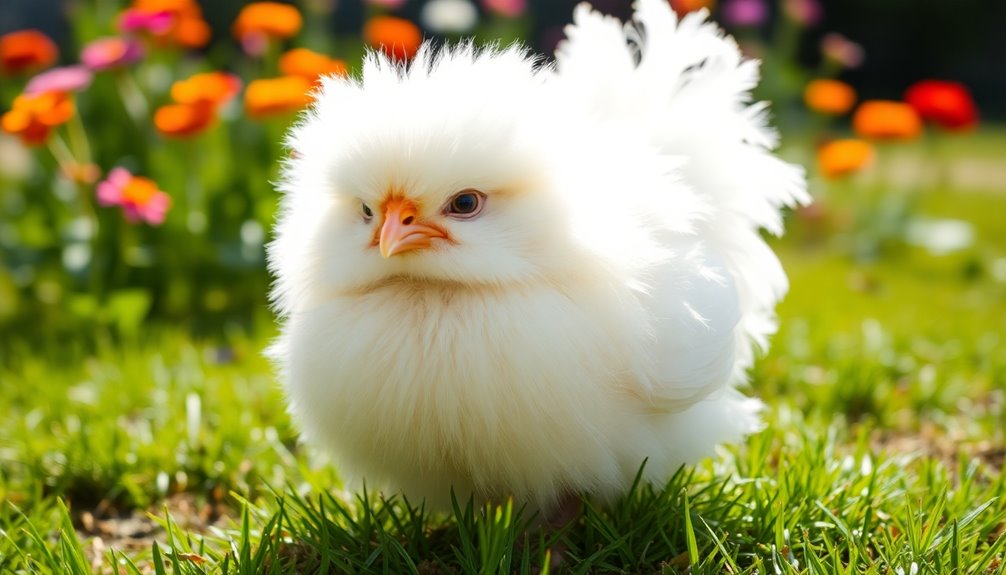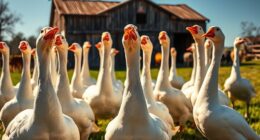Keeping your chickens warm in winter starts with ensuring their coop is well-insulated and ventilated. Use the deep litter method for added warmth and make sure to seal any drafts. Provide high-protein feed and warm treats to keep their energy up. Monitor their water supply to prevent freezing and offer plenty of space to roost comfortably. With the right setup, they can thrive in colder weather. Discover more tips to enhance their winter care.
Key Takeaways
- Implement the deep litter method using straw and wood chips to provide natural insulation and warmth for your chickens.
- Ensure proper ventilation by positioning openings high in the coop to allow warm air to escape while preventing ammonia buildup.
- Provide high-quality feed with increased protein levels to support energy needs and keep your chickens healthy during colder months.
- Regularly check and maintain water sources to prevent freezing, ensuring chickens have access to fresh, unfrozen water at all times.
- Monitor the coop environment for drafts and seal gaps around doors and windows to maintain warmth and comfort for your flock.
Preparing Your Coop for Winter
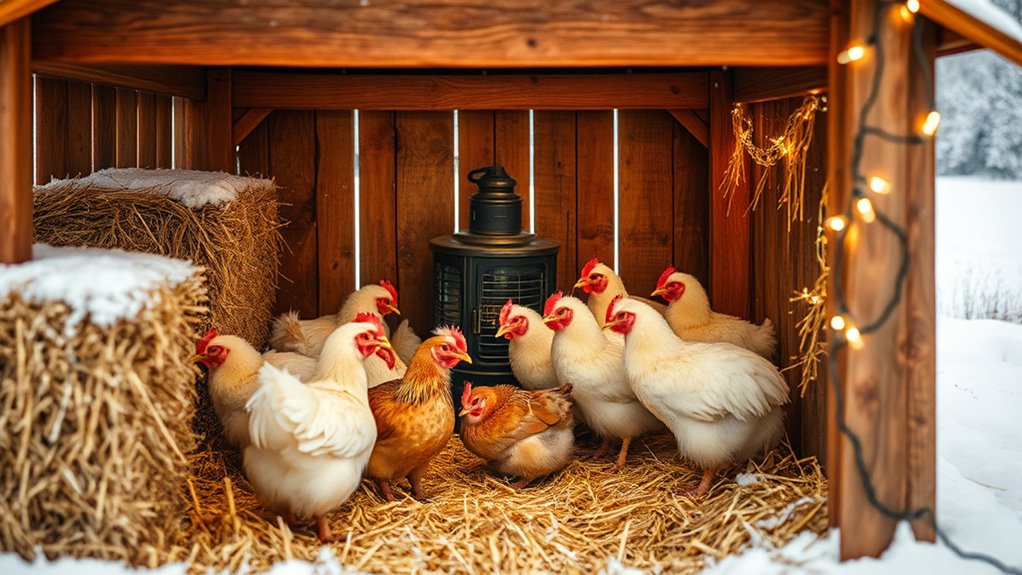
As winter approaches, you need to prepare your coop to keep your chickens warm and safe from the harsh elements. Start by inspecting and repairing any leaks or damages to guarantee proper insulation.
Implement the deep litter method using organic materials like straw and wood chips, which not only insulate but also generate warmth through composting.
Position ventilation openings high on the coop walls to allow warm air and moisture to escape while preventing cold drafts from reaching your chickens.
Take advantage of natural sunlight by placing windows strategically to capture heat during the day.
Regularly monitor the temperature and humidity levels in your coop to maintain a comfortable environment, avoiding excessive heating that could lead to moisture buildup and health risks.
Insulation and Ventilation Strategies
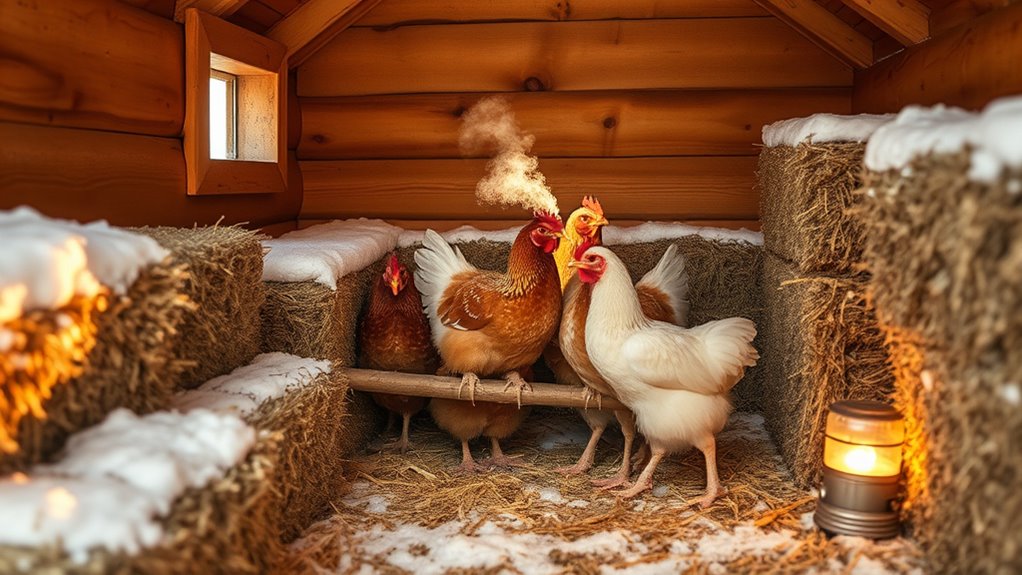
After guaranteeing your coop is ready for winter, focus on insulation and ventilation strategies that keep your chickens cozy.
Start by implementing the deep litter method; layering organic materials like straw or wood chips provides natural insulation and helps maintain warmth.
Confirm you have proper ventilation—one square foot per chicken—to prevent ammonia buildup and allow moisture to escape without creating drafts.
Position vents high on the coop walls, allowing warm air to exit, while sealing gaps around doors and well-insulated windows blocks cold drafts.
Regularly check for air leaks and seal any gaps in older coops to minimize heat loss.
These steps will help keep your coop warm and your chickens comfortable all winter long.
Effective Heating Options
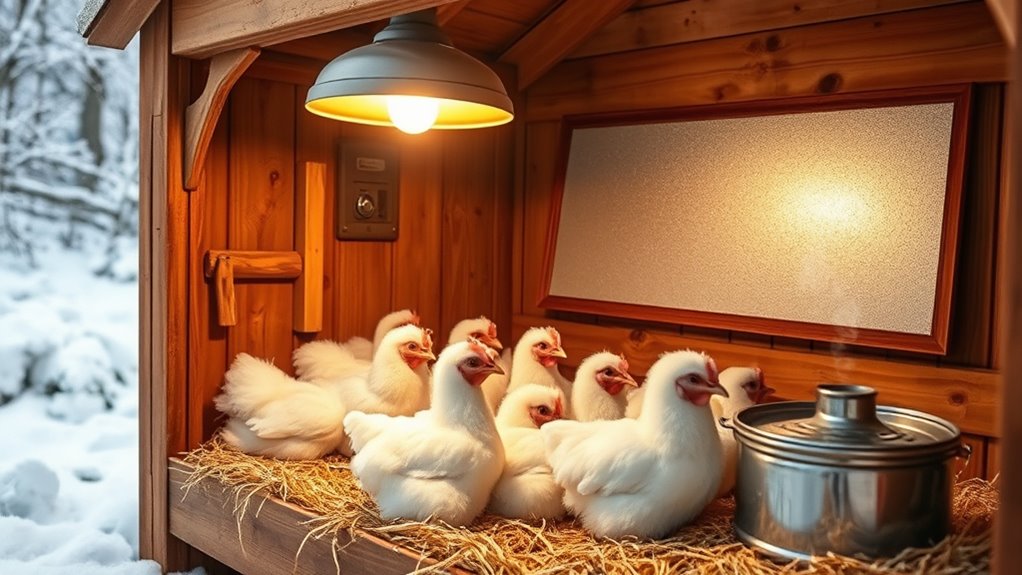
When winter temperatures plunge, ensuring your chickens stay warm becomes essential, and effective heating options can make a significant difference.
While heat lamps can help, use them cautiously—especially with young chicks—to avoid burns and overheating. Instead, consider bulb heaters, which are safer and more effective for keeping chickens comfortable in cold climates.
Exercise caution with heat lamps for young chicks; opt for safer bulb heaters to ensure comfort in cold climates.
Proper placement of any heating equipment is vital; keep heaters away from flammable materials and check them regularly for safety.
Additionally, implement insulation methods like the deep litter method to retain heat in the coop, reducing the need for excessive heating.
With adequate protection from wind and cold, chickens can stay comfortable even in temperatures as low as -20°F.
Nutritional Support for Winter

To keep your chickens healthy and energetic during winter, it's crucial to provide them with the right nutrition. Focus on high-quality feed with 16-18% protein to support their energy levels, especially for hens in molt who need 21% protein for re-feathering.
Supplement their diet with cracked corn or scratch grains in the evening; this boosts calorie intake and helps generate body heat as they digest overnight. Offering warm oatmeal or mash can also stimulate appetite and encourage feed intake when temperatures drop.
Consistently check and replenish their feed to guarantee they've continuous access to essential nutrition. By monitoring feed quality and adjusting offerings based on weather conditions, you'll greatly enhance your chickens' health and resilience during the winter months.
Managing Space and Roosting
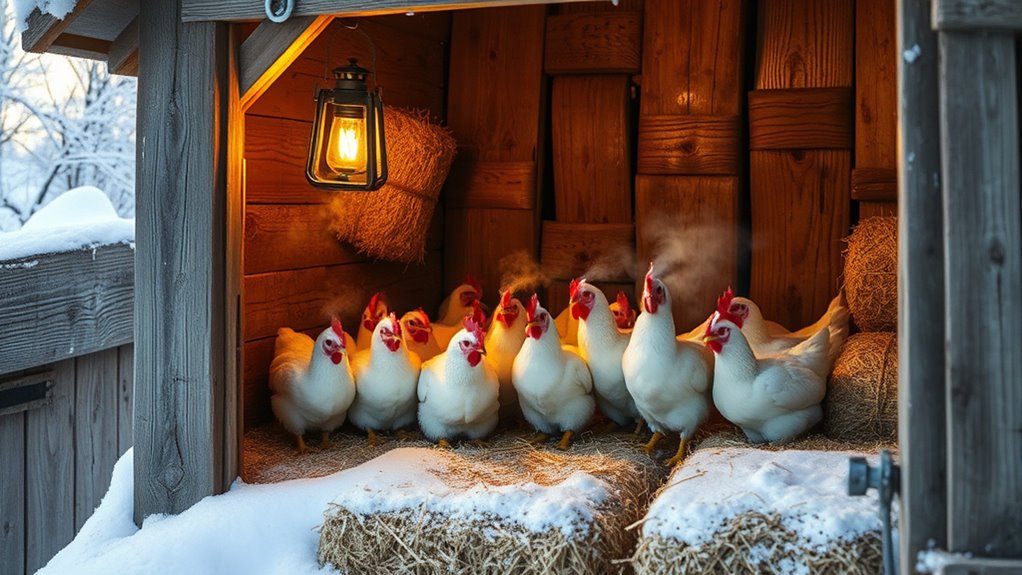
Providing your chickens with the right nutrition sets the foundation for their winter health, but managing their space and roosting is equally important for keeping them warm. Here are some tips to guarantee your flock stays cozy:
- Raise roosting bars close to the ceiling to maximize heat retention; warm air rises and keeps them comfortable.
- Allow 8-12 inches of space per bird on the roosting bars to prevent overcrowding and promote warmth.
- Implement the deep litter method in the coop; a thick bedding layer provides insulation and warmth.
- Monitor flock behavior during colder months; smaller groups may need closer observation for cold stress, while larger flocks generate heat collectively.
Outdoor Considerations for Chickens
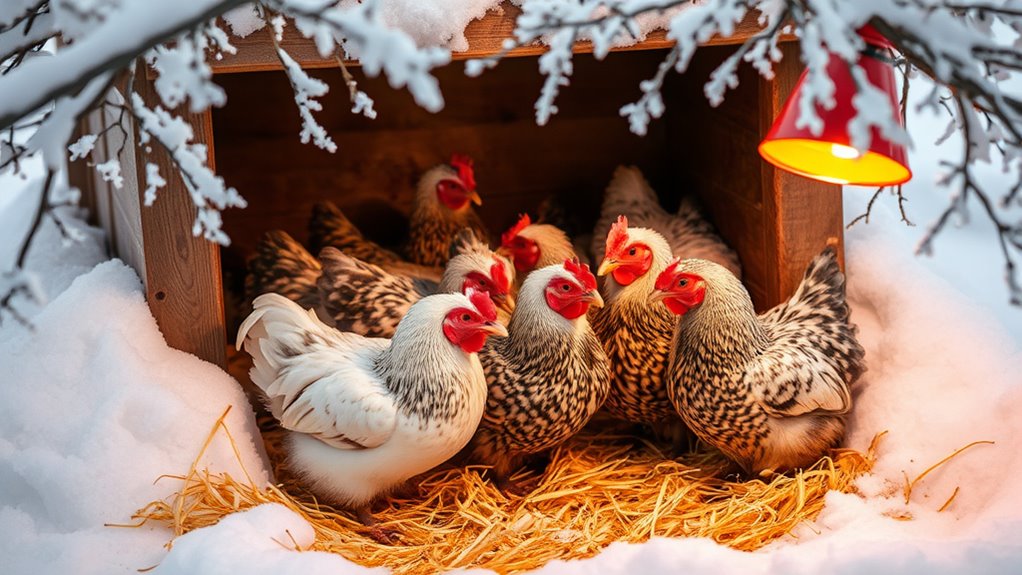
When winter hits, setting up a winter yard with organic materials like cornstalks and wood chips keeps your chickens active and warm.
A sunroom or greenhouse-style run also lets them soak up some sunlight, boosting their overall health.
These outdoor considerations are essential for keeping your flock comfortable and safe during the colder months.
Winter Yard Setup
Creating a winter yard setup for your chickens is vital for their comfort and well-being during the colder months.
To guarantee they thrive, consider these key elements:
- Diverse Organic Matter: Use piles of cornstalks and wood chips for foraging opportunities and natural insulation.
- Heated Waterers: Install a heated water source to keep hydration accessible and prevent freezing.
- Ventilation System: Guarantee proper airflow to avoid moisture buildup, which is essential for moisture control.
- Covered Areas: Create sheltered zones to protect against snow accumulation and wind chill.
Sunroom for Chickens
A sunroom for chickens offers an excellent way to enhance their outdoor environment during winter. This sheltered space captures sunlight, providing warmth and encouraging natural foraging behavior.
By incorporating organic matter like cornstalks and wood chips, you'll improve insulation and create foraging opportunities for your chickens. Building the sunroom with clear or insulated panels maximizes sunlight penetration while minimizing heat loss, ensuring a comfortable area even on chilly days.
Regularly monitor the temperature and airflow inside the sunroom to maintain a safe environment, preventing overheating or moisture buildup. Implementing energy-efficient models in your heating solutions can further enhance the comfort of your chickens during colder months.
With access to this cozy space, your chickens will thrive, reducing stress and promoting healthy behaviors, even in colder temperatures.
Invest in a sunroom, and watch your flock flourish!
Monitoring Chicken Health During Winter
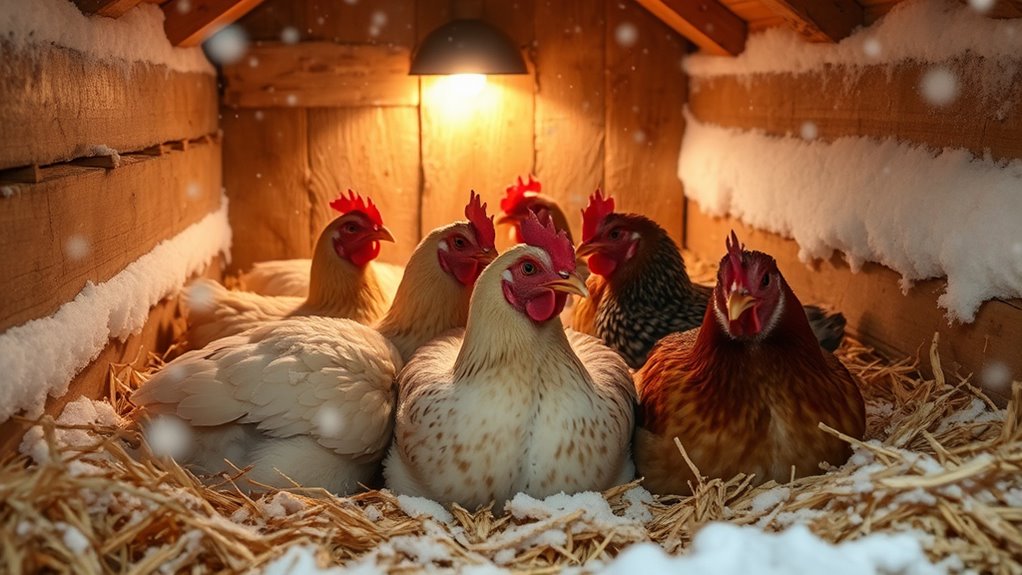
As winter sets in, you need to keep a close eye on your chickens' health.
Watch for signs of discomfort, conduct regular health checks, and adjust their nutritional needs to guarantee they stay healthy and warm.
Signs of Discomfort
To guarantee your chickens stay healthy during winter, it's crucial to monitor their behavior for signs of discomfort. When temperatures drop, chickens need to be observed closely to confirm they're not suffering.
Here are some key signs to look for:
- Huddling Together: Indicates they need more warmth or better insulation.
- Signs of Frostbite: Darkened combs or wattles are clear indicators of distress from cold air.
- Excessive Vocalizations: Unusual sounds may signal stress due to inadequate temperature control.
- Reduced Egg Production: A drop in laying can suggest your flock is uncomfortable from cold temperatures or moisture-laden air.
Being vigilant about these signs helps you keep your chickens warm and healthy throughout winter.
Regular Health Checks
While winter brings its challenges, keeping a close eye on your chickens' health can make a significant difference in their well-being. Regular health checks are essential to guarantee your flock stays warm and healthy.
Monitor for signs of frostbite on combs and wattles, especially in breeds with larger appendages. Pay attention to respiratory issues; coughing or nasal discharge often signals poor ventilation or moisture buildup in the coop.
Make sure your chickens have access to fresh, unfrozen water at all times to prevent dehydration. Assess their overall body condition and behavior, as stress or weight loss can indicate discomfort from low temperatures.
Keeping these factors in check will help maintain the heat and health of your chickens throughout winter.
Nutritional Needs Adjustments
Guaranteeing your chickens get the right nutrition during winter is essential for their health and warmth.
To effectively manage nutritional needs adjustments, consider the following:
- Increase protein intake: Aim for up to 21% protein feed, especially for hens in molt.
- Use cracked corn or scratch grains: Offer these in the evening to boost energy levels and body heat.
- Provide high-quality feed: Automatic feeders can help maintain consistent access to nutrition.
- Hydration is key: Monitor water availability, as frozen sources can lead to dehydration.
Additionally, supplement their diet with warm oatmeal or mash to stimulate appetite and guarantee they're getting the nutrition they need during the colder months.
Frequently Asked Questions
How Cold Is Too Cold for Chickens?
When it comes to how cold is too cold for chickens, you should know that they can handle temperatures as low as -20°F if they're healthy and well-fed.
However, below freezing, especially in windy conditions, the risk of frostbite increases, particularly for chickens with larger combs.
Ideally, aim for a coop temperature of 32-40°F, as they'll huddle together to share warmth.
Always keep an eye on their behavior for signs of discomfort.
How Do You Keep Chickens Warm in Extreme Cold Weather?
To keep your chickens warm in extreme cold weather, start by ensuring their coop is well-insulated with materials like straw bales.
You can implement the deep litter method for added warmth. Consider installing a heat lamp, but be cautious about placement to avoid fire hazards.
Provide high-protein feed to boost their energy, and monitor ventilation to prevent drafts while allowing fresh air.
Finally, offer scratch grains at night to aid digestion and warmth.
Can Chickens Survive Winter Without Heat?
Yes, chickens can definitely survive winter without heat.
They're naturally equipped with insulating feathers, enabling them to withstand temperatures as low as -20°F when properly sheltered.
Focus on providing a well-insulated coop and ensuring good ventilation.
Avoid excessive heating methods, as they can cause moisture buildup, which is harmful.
Just make sure to monitor your flock's behavior and health regularly, as they can adapt to cold conditions quite well when cared for properly.
How Do Amish Keep Chickens Warm?
Amish farmers keep chickens warm by using traditional building methods, like thick walls and straw bales for insulation.
They rely on the deep litter method, which not only insulates but also generates warmth through composting.
You'll find that they emphasize good ventilation to avoid moisture, preventing frostbite.
Feeding chickens a high-protein diet helps them maintain body heat, while sheltered outdoor runs allow them to stay active and enjoy sunlight.
Conclusion
As winter blankets your yard in frosty white, keeping your chickens cozy becomes a heartfelt mission. With the right insulation, thoughtful heating, and nutritious support, you can transform their coop into a warm haven. Remember, a happy flock is like a well-tuned orchestra; every detail matters to create harmony. By nurturing their health and managing space, you guarantee your chickens thrive through the chill, ready to greet the spring sun with clucks of gratitude.

